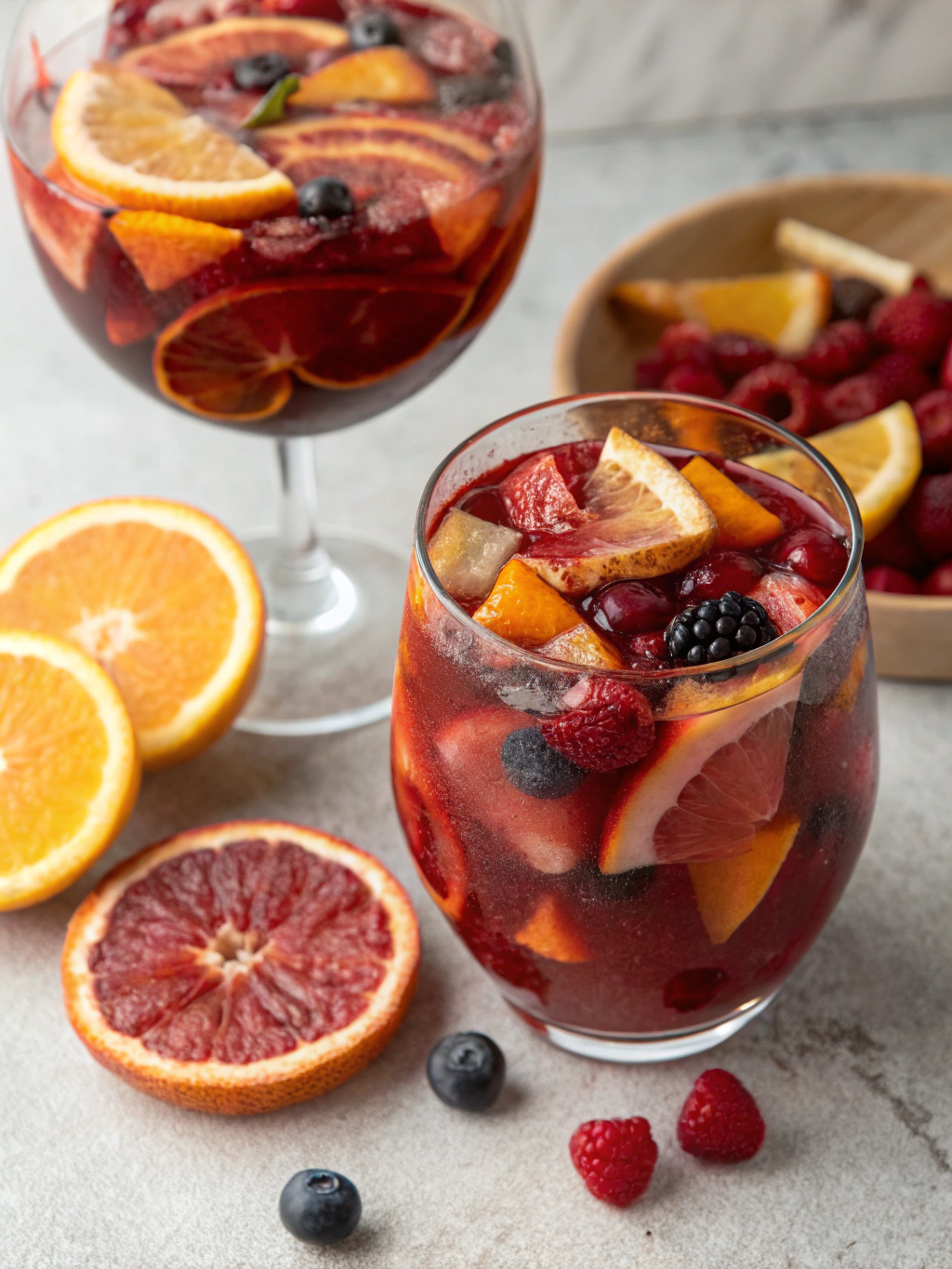Last Updated on April 9, 2025 by recipeinspire
Table of Contents
Shark Attack Sangria: A Refreshing Twist for Your Summer Gatherings

Sipping a refreshing drink can make any summer gathering more enjoyable, and what better way to celebrate than with a unique twist like shark attack sangria? This cocktail captures the spirit of summer while also fitting perfectly into the popular theme of Shark Week. Combining fruity flavors with a splash of creativity, this drink not only looks impressive but tastes delightful.
The idea of shark-themed drinks has gained traction, especially during events like Shark Week. Shark attack sangria mixes traditional sangria ingredients with a fun twist, making it perfect for parties or casual get-togethers. Whether it’s for a viewing party or just a summer refreshment, this cocktail is sure to impress guests and spark interesting conversations.
With its vibrant colors and tasty ingredients, shark attack sangria is more than just another drink; it’s an experience. By balancing flavors and creativity, it highlights the excitement of summer while reminding everyone of the fascinating world of sharks.
Key Takeaways
- Shark attack sangria is a fun and creative cocktail for summer events.
- The drink combines fruity flavors with a shark-themed presentation.
- It serves as a great conversation starter for gatherings.
Understanding Shark Behavior
Sharks are complex creatures with unique behaviors shaped by their habitats, diets, and common misconceptions. Understanding these aspects can help clarify their role in the ocean ecosystem and dispel myths surrounding them.
Habitats and Migration Patterns
Sharks inhabit various environments, including coastal waters, deep seas, and open oceans. Many species prefer shallow areas near continental shelves where prey is abundant.
Sharks are also known for their migration patterns. For instance, the great white shark travels long distances to follow prey like seals.
Some species, like the tiger shark, migrate seasonally to find warmer waters. Understanding these patterns is crucial for conservation efforts and safety measures in coastal regions.
Diet and Feeding Habits
Shark diets vary widely depending on species. Some are apex predators, like the great white, which primarily feeds on marine mammals. Others, like the whale shark, are filter feeders that consume plankton and small fish.
Feeding habits also depend on size and habitat. Sharks often use ambush tactics to catch prey, striking quickly from below.
Their keen sense of smell helps them detect prey from far distances. Knowing what sharks eat can improve safety awareness when swimming in their habitats.
Common Misconceptions About Sharks
Many people fear sharks due to common myths. A major misconception is that sharks attack humans frequently. In reality, most incidents result from mistaken identity or curiosity.
Sharks do not seek humans as food. They might bite out of confusion, mistaking a swimmer for their natural prey, like a seal.
Another myth is that all sharks are dangerous. In truth, only a few species are known to engage in attacks. Understanding these facts can help reduce unnecessary fear and promote awareness about shark conservation.
History of Shark Attacks
Shark attacks have a long history, often stirring fear and fascination. Various incidents have marked key moments in this history, influencing public perception of sharks. Additionally, studying statistics provides insight into patterns of these attacks.
Notable Shark Attacks in History
One significant event occurred in 1916 along the Jersey Shore. During this summer, a series of shark attacks resulted in the deaths of four people and injuries to others. This led to widespread panic and contributed to changes in beach safety.
Another infamous incident took place in 1975, when the movie “Jaws” was released. The film, inspired by real shark attacks, heightened fears about these creatures. Reports of shark incidents increased after its release, cementing a dramatic shift in public perception.
Statistics and Patterns
According to the International Shark Attack File, the United States has the highest number of documented shark attacks. The file tracks incidents dating back to the early 1500s and includes over 6,800 cases. These attacks are more common in warm coastal waters, particularly in Florida and California.
Seasonality also plays a role in shark attacks. The summer months see a rise in beachgoers, increasing the chances of encounters. Most attacks are not fatal, with many victims suffering minor injuries. Understanding these patterns helps to inform safety measures and reduce fear.
Shark Attack Prevention
Preventing shark attacks involves understanding safety measures for those in the water and utilizing technology designed to deter sharks. The following sections outline essential tips and advancements in shark safety.
Safety Tips for Swimmers and Divers
Swimmers and divers can take several steps to reduce the risk of shark encounters. Important safety tips include:
- Avoid Low Light Hours: Sharks are often more active during dawn and dusk. Staying out of the water during these times can lower risk.
- Stay in Groups: Sharks are less likely to approach a group of people than a single individual. Swimming with others can enhance safety.
- Refrain from Bleeding: Blood can attract sharks. It is vital to avoid swimming with open wounds or during menstruation.
- Watch for Sharks: If a shark is spotted, exit the water calmly and quickly. Splashing can attract their attention.
By following these guidelines, swimmers can minimize the chances of an unwanted encounter.
Technologies to Deter Sharks
Innovative technologies are being developed to help keep swimmers safe from sharks. Some effective solutions include:
- Shark Spotting Apps: Tools like the Dorsal app allow users to report and receive updates about shark sightings in their area. This information can help swimmers make informed decisions.
- Buoys and Shark Nets: Some beaches use buoys equipped with sonar technology to detect sharks nearby. Shark nets can also reduce the number of sharks entering swimming areas.
- Electromagnetic Deterrents: Devices that emit electric fields can deter sharks by creating an uncomfortable environment for them, leading them to leave the area.
Implementing such technologies can greatly enhance safety for those enjoying the ocean.
First Aid and Medical Response
Prompt and effective first aid is crucial in the event of a shark attack. Addressing immediate injuries and ensuring proper medical care can significantly aid recovery.
Immediate Actions After a Shark Attack
First and foremost, controlling bleeding is essential. The victim should be moved to safety to avoid further injury. If possible, apply pressure to the wound using a clean cloth or bandage. If the bleeding is severe, a tourniquet may be necessary, applied above the injury site but only as a last resort.
Calling emergency services should happen immediately. While waiting for help, the victim should remain as calm and still as possible to prevent further blood loss. Monitoring their breathing and heart rate is important; begin CPR if there is no pulse. It’s also crucial to assess for shock, which can occur due to significant blood loss.
Long-Term Medical Care
After the initial emergency response, long-term care becomes vital to recovery. Victims often require surgery to repair damaged tissues or bones. Rehabilitation may also be necessary to help restore function and mobility.
Psychological support is essential. Many survivors experience PTSD or anxiety following a shark attack. Mental health professionals can aid in coping and recovery. Regular follow-ups with healthcare providers ensure that any complications are addressed promptly. In addition, education about preventing future attacks can empower individuals and enhance their sense of safety while enjoying ocean activities.
Conservation Efforts for Sharks
Sharks are vital to ocean ecosystems, and their populations face serious threats. Effective conservation efforts include laws to protect sharks and initiatives aimed at restoring their numbers.
Shark Protection Laws and Regulations
Many countries have enacted laws to protect shark species from overfishing and exploitation. These regulations often include fishing quotas, size limits, and bans on shark finning.
For example:
- International Treaties: Agreements like CITES help regulate trade in endangered shark species.
- Local Laws: Some areas have shark sanctuaries that prohibit fishing entirely.
Regulations may vary by region, but the goal is to create sustainable fishing practices that allow shark populations to recover. Compliance enforcement plays a crucial role, ensuring that these laws are followed across commercial fisheries.
Impact of Conservation on Shark Populations
Conservation efforts have shown positive results in specific shark populations. By implementing protective measures, some regions have observed a gradual increase in shark numbers.
Key points include:
- Sustainable Practices: When fishing is done sustainably, it helps maintain healthy shark populations.
- Public Awareness: Educational campaigns raise awareness about the importance of sharks and their role in the ecosystem.
In areas where conservation efforts are actively enforced, the benefits become clear. For instance, some shark species in marine protected areas thrive, increasing biodiversity and stability in marine environments. Continued focus on conservation is vital for ensuring sharks remain a crucial part of ocean ecosystems.
Sangria and Culinary Traditions
Sangria has deep roots in Spanish culture and has evolved over time into various regional specialties. The mix of wine, fruit, and additional flavors reflects local ingredients and traditions. Understanding its history and popular recipes provides insight into its significance in culinary practices.
History of Sangria
Sangria originated in Spain, drawing its name from the Spanish word for blood, “sangre,” which refers to the red wine used in the drink. Its beginnings can be traced back to the 18th century, where it was consumed as a refreshing beverage during warm months.
Originally, sangria was a simple mixture of wine, water, and fruits. Over time, it evolved to include a variety of spirits and sweeteners, making it more flavorful. Throughout the years, sangria has become a staple at festivals and social gatherings, reflecting the spirit of Spanish hospitality.
Popular Sangria Recipes
Sangria can be made in many different ways, allowing for creativity and personal taste. Here are a few popular recipes:
- Traditional Spanish Sangria: This classic version uses red wine, chopped fruits like oranges and lemons, and a bit of brandy. Sweetener such as sugar or orange juice can be added for taste.
- White Sangria: A refreshing twist that incorporates white wine, fruit like peaches and berries, and a splash of soda water or lemon-lime soda.
- Seasonal Variations: Sangria can be adapted with seasonal fruits. For instance, in winter, cranberry and apple can be used, while summer might feature watermelon and mint.
These recipes display the versatility of sangria, making it a popular choice in various culinary settings.
Combining Themes: Shark Attack Sangria
This festive drink is perfect for summer gatherings and shark-themed parties. By blending fun cocktail ideas with tasty snacks, hosts can create an exciting atmosphere for their guests.
Creating Themed Cocktails
Shark Attack Sangria is a creative and visually striking drink. It can be made with red wine, chopped fruits, and a splash of berry-flavored soda.
Ingredients:
- 1 bottle red wine
- 2 cups mixed fruit (such as strawberries, oranges, and peaches)
- 1 cup berry soda
- Gummy sharks for garnish
To prepare, combine the wine and fruit in a large pitcher. Add the soda, and let it chill in the refrigerator for at least two hours. Just before serving, garnish each glass with gummy sharks. This adds a playful touch and fits the shark theme perfectly.
Food and Drink for Shark-Themed Events
Pairing the sangria with the right snacks enhances the theme. Creative food options can complement the Shark Attack Sangria and keep guests engaged.
Suggested Snacks:
- Shark Fin Nachos: Use blue corn chips and top with cheese and jalapenos.
- Gummy Shark Treats: These add a fun element and tie into the drink theme.
- Shark Bite Sliders: Mini burgers can be shaped like shark fins using cookie cutters.
Serving a mix of finger foods is ideal for parties. Easy-to-eat snacks encourage mingling and enjoyment. This makes each moment memorable while keeping the shark theme alive throughout the event.
Frequently Asked Questions
This section addresses common questions about preparing Shark Attack Sangria and other related drinks. The focus will be on ingredients, specific recipes, and variations, providing clear instructions for readers interested in these unique beverages.
How do you prepare a Shark Attack Sangria?
To prepare Shark Attack Sangria, start with a base of red wine, typically a fruity variety. Add an assortment of sliced fruits like oranges, limes, and berries. For added depth, include some fruit juice and a splash of soda for fizz. Let it chill for a few hours before serving to enhance the flavors.
What ingredients are needed for a non-alcoholic Shark Attack drink?
For a non-alcoholic Shark Attack drink, use a combination of fruit juices such as cranberry, pineapple, and orange juice. Include sparkling water or soda for carbonation. Slices of fruits like lemons, limes, and cherries can add a refreshing touch.
What is the recipe for a Shark Bite cocktail?
The Shark Bite cocktail consists of rum, blue curaçao, and grenadine. To create it, mix rum and blue curaçao in a shaker with ice. Pour into a glass and slowly add grenadine, which will sink to create a layered effect.
How can I make the Shark Bite drink from Applebee’s?
To replicate the Shark Bite drink from Applebee’s, combine coconut rum, blue curaçao, and a splash of pineapple juice. Shake the ingredients with ice and strain into a glass. Add grenadine for the finishing touch, creating a colorful drink.
What’s involved in making the Hangout Shark Attack beverage?
Making the Hangout Shark Attack beverage requires a mix of vodka, blue curaçao, and lemonade. Combine these ingredients in a glass filled with ice. Garnish with gummy sharks or colorful fruits for a playful presentation.
Can you make Shark Attack Sangria using Sprite?
Yes, Shark Attack Sangria can be made using Sprite. Replace the soda or sparkling water with Sprite for a sweeter flavor. This substitution adds a bubbly, refreshing element to the traditional sangria recipe.
Print
shark attack sangria
Description
Sipping a refreshing drink can make any summer gathering more enjoyable, and what better way to celebrate than with a unique twist like shark attack sangria? This cocktail captures the spirit of summer while also fitting perfectly into the popular theme of Shark Week.
Ingredients
White wine (750 ml bottle)
Coconut rum (1/4 cup)
Pineapple juice (1 cup)
Watermelon chunks (1 cup)
Blueberries (1/2 cup)
Lime slices (1, thinly sliced)
Ice
Instructions
In a large pitcher, combine white wine, coconut rum, and pineapple juice.
Add watermelon chunks, blueberries, and lime slices.
Chill in the fridge for at least 2 hours.
Serve over ice.
More Drinks:








